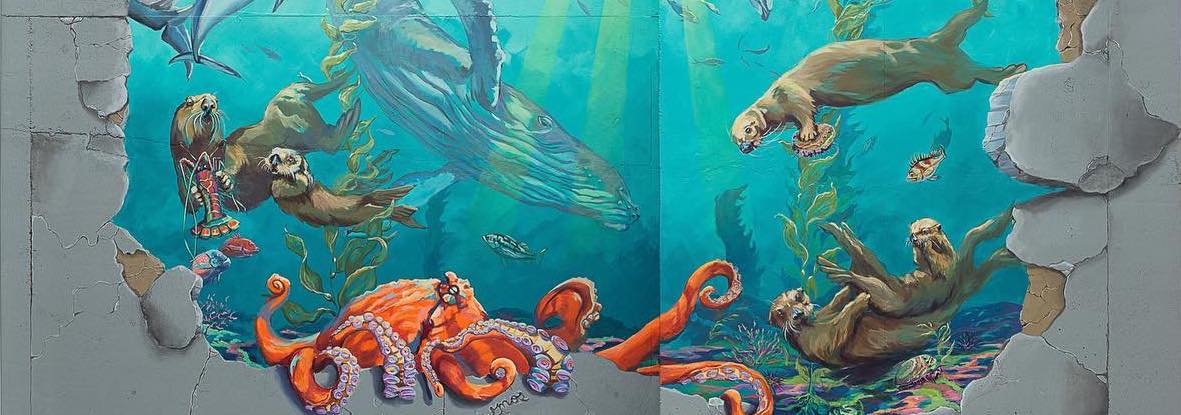Mural photos by Elliott Johnson
Shell Beach artist Colleen Gnos is known for creating a magical world of mermaids and abalone divers, surfers and breaking waves, all reflecting her deep fascination with the sea. Gnos has painted murals for more than 20 years, ranging from lifeguard stations in Avila Beach to the inside of a church in Dixon, California. She has been voted the county’s “Best Visual Artist” six times. Her new mural, “Mother Ocean Breaks Free,” is a 19-by-16-foot trompe l’oeil piece that was a private commission for property at 225 1st Street in Avila. We caught up with the busy artist to talk about the project and how she approached it.
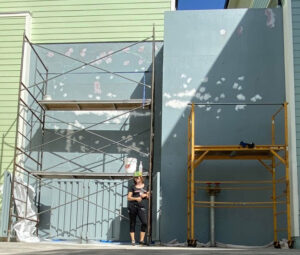
David Congalton: How did you first develop an interest in painting murals?
Colleen Gnos: When I returned from Florence, Italy after studying art for a year, I was in my senior year at UC Santa Cruz working on my B.A. degree in studio arts. The theater company, Shakespeare Santa Cruz, was asking for a student from the art department to paint a 5-by-5-foot Byzantine Jesus. I jumped at the opportunity, since I had just spent a year surrounded by Byzantine art. Working at that size was liberating and exciting. I added in gold leaf and distressed the image to make it appear 500 to 600 years old and received a great deal of positive feedback. They offered me a paid position, painting the theatrical sets, and it was there that I learned from master set painters how to bridge an artwork from 30-by-40-inches to 30-by-40-feet—even while painting a backdrop that was attached to the floor, where you cannot get perspective to see what you’re doing. It was a natural transition to murals, as people who worked in theater frequently asked me to paint murals in their homes.
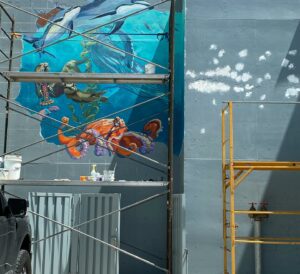
DC: How did you get the commission for the “Mother Ocean Breaks Free” mural in Avila?
CG: My client is a children’s book illustrator and muralist who has an arts-supporting husband. They built a condominium complex in downtown Avila that had a big gray wall. She was in love with the lifeguard tower artwork, and wanted to find the artist who did the lifeguard towers and ask them to put something colorful and fun on that boring gray wall.
DC: How much freedom did you have in terms of creating the mural? Was it your vision or did they hire you to paint a specific theme?
CG: Most of my clients give me a lot of freedom and trust my concepts. They usually have a general idea of what they want, such as an underwater or agriculture theme, and I have a discovery session with them to find out their preferred colors, places to visit, and imagery. After that, I come up with multiple sketches that they can ask for changes. For this project, after seeing my sketches that included some Atlantis ruins and submerged Polynesian artifacts, they decided they didn’t want any sign of humans, just underwater playful creatures, especially sea otters.
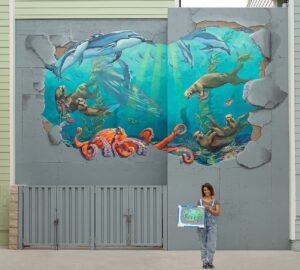
DC: Share a little of the process. How does a mural come together in your head? How did you decide what it was going to be?
CG: I literally sit at the “drawing board” with my sketchbook. I brainstorm a bunch of ideas and create many low detail thumbnail sketches at about 2-by-2 inches—this helps me focus my ideas and play around with the larger elements of composition, which can make or break a work of art. My theory is that if it looks good at 2-by-2 inches it will usually look good at a larger size. From there, I pick the top sketches and make them scale, around 4 inches, then create the better compositions at 8 inches. The final rendering sketches will end up being about around 10 to 12 inches—those are the ones I present for my client to look at and make possible changes. The initial sketches are black and white, so as not to be distracted by attractive colors. In the final round of sketches, I add in color.
DC: Then the second step of the process must be the physical painting. How long did it take? What kind of materials did you use? Any problems on this project? Is it difficult to paint a mural?
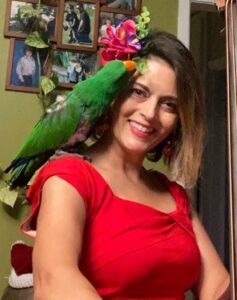
CG: Much of the time is in the prep work—and every job is different. Sometimes I’m able to create a mural on panels or non-woven cloth in my studio; other times, it’s not possible or desirable. The prep is designing the mural to fit the site, deciding which products will suit the surface best, consulting architectural coating specialists and other muralists, doing test panels, ordering materials, arranging scaffolding and other equipment, acquiring permits, and hiring subcontractors and assistants for various stages of the job—basically acting as a general contractor for the job.
My husband, Che Miller, is a professional problem solver, so I always consult with him on the tools and equipment for the job. I’d rather do as much as I can in the studio before I sweat it out on the job site. I often consult with the outstanding mural restorer Scott M. Haskins, who always has solid advice on how to make a mural last for decades since he restores aging murals and 500-year-old frescos around the world.
Unique to this job in Avila was the weather and the fact that I was painting it on a concrete wall. Along the Central Coast our weather is usually acceptable for painting murals year-round. I planned to start this job in January of 2023. The wall was going to require quite a bit of patch work due to the large pits in the concrete surface. The company that sells the patching compound brought to my attention that the wall needs to be at least 50 degrees for the patch to cure. I began taking wall temp readings to find that the surface was soaking wet from the storms and lingering around 35 to 38 degrees. Neither the patching compound nor the paint will cure below 50 degrees. The wall didn’t start to warm up until early April when the sun had moved into the sight line and began to warm the wall in the afternoon.
Once I got on the wall and set up the scaffolding, I noticed a few areas of efflorescence where minerals were leaking from behind the concrete wall. These needed to be cleaned up, patched and waterproofed. I snapped a chalk grid on the surface, got the coat of primer down, and worked on one wall at a time. It did rain over a few days during the project, which delayed me about a week.
Public art has the ability to elevate a community, and create discussion and a sense of pride for those who live near it.
I’m not sure if it’s difficult to paint a mural—it’s certainly more fun, physical and satisfying than working on a small painting in my studio. I love physically demanding work. I think the hard part is preparing to paint since there are so many moving parts and steps that need to be completed and resolved before I can start the fun part of painting. Then when I am finally on the wall, I can be singularly focused on the art.
DC: Did the vision change at all from beginning to end?
CG: Not really. I used the rendering as my guide. Working with three different walls, I had to create a forced perspective on-site that could not be worked out beforehand. My client remembered she wanted a sea turtle, so I added one in at the end of the project.
DC: You’ve done multiple murals over the years. Why are they important? What does a public mural offer?
CG: Public art has the ability to elevate a community, and create discussion and a sense of pride for those who live near it. It defers graffiti and often adds beauty and wonder to an area. I think that’s pretty important. I put my heart into my projects and it’s an honor to be able to share my vision with the community.
DC: You must feel very proud of this mural. What about future projects?
CG: On July 18, I will do a “re-paint” of a mural I did back in 2013. The January storms ripped 30 percent of the mural off the wall. It was painted on cement siding that became loose when the 70 mph winds worked their way behind the siding. The mural was a tribute to agriculture, and an icon to the GrowWest company, to the Woodland, California community, and to the truckers who drive Hwy 5 and Hwy 113. They decided to bring me back to repaint it. This job will take over a month and 40 gallons of paint, and I will be using two 65-foot articulating boom lifts. I will need to renew my aerial lift operator license. The top of the mural is 65 feet high.
In January, I will begin a historical mural for the Dixon Historical Society. It will be 14-by-14-foot and I will create it on aluminum panels in my studio, and my husband and I will install it on the wall in late spring. I’m hiring master welder Rick Gordon to weld the back structure for this project, like he did for the Avila Aquarium murals. I heavily research every mural I create, so I’m excited to learn about the history of the little town I grew up in. It’ll include imagery from the indigenous people, the Wintun, the Californios, agriculture and more.
DC: And you’re also still playing the upright bass around town with The Mother Corn Shuckers. How is that going and what does music provide you as an artist?
CG: My husband Che Miller keeps writing wonderful songs that I love playing bass to, and the band has a lot of gigs so I’m pretty busy as an upright bass player. It’s not an easy instrument to carry around to practice and shows, and is difficult to dial in sound; it picks up so many different tones and resonates, sometimes feeding back onstage. I’ve also started playing gut strings (made from bovine intestines), which have a beautiful warm tone and are a pleasure to play, but are also difficult to keep in tune when playing outdoors. They are affected by changes in temperature and humidity. Most bass players just don’t want to deal with this and play electric. Since I’m not a trained bass player, I feel like I can get more creative and more expressive since I don’t know the “rules” like I do with visual art. I’ve played various instruments since I was about six years old, so I use my ear to have fun playing around with different tones, percussive snaps and walking bass lines. I have a lot of fun and I always feel so much happier once I start playing. I process rhythm as a visual representation, so it’s like creating a work of art with sound.
Editor’s Note: This conversation has been edited for length and clarity.
